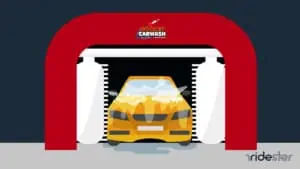If you don’t use navigation apps in your daily life, you’re part of a small minority. People all over the world rely on apps like Waze and Google Maps to get around their city without having to memorize their route.
In this guide, we’ll provide a comprehensive head-to-head comparison between the two apps and tell you which one is the better fit for you.
- Waze Vs Google Maps [At a Glance]
- Brett’s Take: Thoughts From an Expert
- 1. User Interface and Design
- 2. Navigation and Routing Accuracy
- 3. Traffic Data and Real-Time Updates
- 4. Offline Functionality
- 5. Additional Features and Integrations
- 6. Voice Navigation and Commands
- 7. Data Usage and Battery Consumption
- 8. Community and Social Features
- Waze Vs Google Maps: Pros and Cons Summary
Waze Vs Google Maps [At a Glance]
Considering that both Google Maps and Waze are under the umbrella of Google, you’d expect the two apps to be rather similar.
Yet, the two navigation apps have a lot of differences and Google has kept them separate. Not only that, but the two apps also work in completely different ways.
While Google Maps makes the most out of Google’s endless archive of data, Waze gets its navigation data by crowdsourcing it from its users. Waze is also more assertive in getting you from point A to point B in the shortest possible time.
As far as availability goes, both apps are available on all Android and iOS devices. They also work seamlessly with both Apple CarPlay and Android Auto. That means you can choose between the two apps regardless of the device you use or the car you drive.
Which choice is best for you, though?
| Feature | Google Maps | Waze |
|---|---|---|
| User Interface & Design | Simple, functional design | Minimalistic, user-friendly design with more customization options |
| Navigation & Routing | Versatile for various modes of transport (car, motorcycle, cycling, walking, public transport) | Optimized for car and motorcycle use |
| Traffic Data & Real-Time Updates | Shows congestion and delay times; sometimes suggests alternate routes | Actively changes route to avoid traffic and minimize journey time |
| Offline Functionality | Offline maps available | Requires active internet connection |
| Additional Features & Integrations | Limited ads; integration with other Google apps and services; Google Calendar integration | More prominent ads; integration with Spotify, Uber, Lyft; extensive voice customization |
| Voice Navigation & Commands | Limited voice command options; one voice per region | Extensive voice command customization; celebrity voices available |
| Data Usage & Battery Consumption | Higher data usage (0.73 MB/20 min, approx. 2.2 MB/hr) | Lower data usage (0.23 MB/hr); can be turned off to save data |
| Community & Social Features | Relies on extensive data sources and aggregated third-party data | Community-driven data for real-time updates; user reports on traffic, road conditions, accidents |
| Pros | Extensive database; offline functionality; versatile for various transport modes; simple UI | Customizable voice commands; real-time community updates; user-friendly UI; optimized for cars and motorcycles; less data usage |
| Cons | Limited customization; higher data usage; lacks community features | No offline functionality; limited to car/motorcycle navigation; privacy concerns with user data collection |
| Suitability | Ideal for diverse modes of transportation and offline use | Best for car or motorcycle users who value real-time community-driven updates and customization |
Brett’s Take: Thoughts From an Expert
Google Maps and Waze are among the most popular navigation apps in the world for a reason.
They both offer a great user experience and excellent features. But, which one is the better fit for you? Well, that depends on your priorities and needs.
If you’re looking for an app that gets the job done with minimal bells and whistles, Google Maps is the way to go.
The app uses a robust database to suggest the best route possible and gives you real-time traffic data that makes its ETA predictions incredibly accurate.
Waze is the better choice if your only mode of transportation is your car or motorcycle.
The app offers excellent customization features to add some fun to your journey, such as customizable voice navigation. It also has a whimsical user interface, with features like Waze icons.
Whichever app you choose, it’ll get you to your destination without any issues.
1. User Interface and Design
When you look at the user interface of Google Maps, it’s clear that Google’s devs decided to play it simple.
Guess what?
Waze’s interface is even easier to use with its minimalistic and sleek design. When learning how to use Waze, it won’t take long because of how user-friendly it is. Waze also offers you a lot more customization options, as we’ll see later on in this guide.
Although this may not be the top choice driver when deciding on a navigation app to use, it definitely plays a role in your overall experience when using the app.
Another great aesthetic feature of Waze is Waze icons. These little pictures that appear within the app are indicators of various things.
For example, there’s an icon to show you when a traffic light has a camera attached, and another to tell you when there’s an accident ahead.
There are also icons that indicate traffic conditions and speed traps.
Google Maps’ navigation capabilities are more versatile than Waze’s.
While Waze is only useful if you’re commuting using a car or a motorcycle, Google Maps will tell how you how to get to your destination and how long the journey will take no matter how you’re moving around.
This means that Google Maps is the better choice for pedestrians, cyclists, and those taking the bus.
As for their routing accuracy, both apps are on-point. Both apps have been around for a long time. Over the years, they’ve compiled extensive databases.
This means that the chances of Google Maps or Waze sending you to the wrong place are slim to none.
3. Traffic Data and Real-Time Updates
A huge part of Google Maps and Waze’s functionality is the traffic alerts they provide and the routes they propose to you.
They both rely on sensing the number of smartphones connected to the internet in a certain area.
The difference between the two apps is how they react to traffic. Google Maps will show you if there’s congestion on your route and can even tell you how long it’ll delay you.
Yet, the app won’t do anything to help you avoid the traffic other than sometimes suggesting alternate routes.
In contrast, Waze’s primary objective is to put you on the fastest route possible. The app won’t merely suggest an alternative route, it’ll change your route by itself to shave some time off your journey’s duration.
4. Offline Functionality
In this aspect, Google Maps is way ahead of Waze.
You can download maps from the app and use it offline. This comes in handy when you don’t have an internet connection.
For example, if you’re passing through an area where the network isn’t the best, you don’t need to worry when using Google Maps.
On the flip side, Waze only works as long as you have an active internet connection.
5. Additional Features and Integrations
Let’s start with something that isn’t necessarily a feature but is super important to your experience on any app, and that thing is ads.
Neither app is ad-free, but Google Maps might as well be because the ads that appear on it are barely visible and don’t get in your way. On the flip side, Waze ads are more prominent in the app’s interface.
Next up, let’s talk customization.
Waze offers much more customizable features, such as several car icons and extensive options when choosing the voice to give you directions.
The feature that sets Google Maps apart from Waze is Street View, which lets you see the place you’re going and confirm that it’s the correct destination.
In terms of integration, both apps are great.
When you use Waze, you can seamlessly stream music from Spotify without leaving the app. You can also book an Uber or Lyft ride directly from the Waze app.
The same applies to Google Maps. While it may not have some of the integration capabilities Waze has, it gives you flawless integration with other Google apps and services.
A good example is Google Calendar integration, which allows you to access your appointments right on the map.
Both apps have voice navigation and command features. But, Waze takes voice navigation to the next level with its customization options.
Modifying Waze voices is super fun! You can install celebrity voices and have the likes of Morgan Freeman and Shaquille O’Neal telling you when to turn.
In contrast, Google Maps only offers one voice option for each region.
7. Data Usage and Battery Consumption
If you look at data usage, you’ll find that Waze uses considerably less data than Google Maps.
On average, Waze uses 0.23 MB each hour. As for Google Maps, the app gobbles up 0.73 MB every 20 minutes. That adds up to about 2.2 MB per hour.
Waze’s lower data usage is thanks in large part to the fact that Waze can be turned off. If you compare Apple Maps vs Google Maps, though, Google Maps comes out on top.
8. Community and Social Features
Looking at community and social features, Waze is hands-down the better app.
It lets users report and input information, which it relies on to pinpoint traffic conditions, road conditions or closures, and accidents. Waze collects this user-generated data and creates real-time updates which it shares with other users to optimize their routes.
Waze also lets you connect with your friends on the app and share your location.
For Google Maps, the lack of community engagement features is because they aren’t necessary. The app relies on the wealth of data sources it has access to, such as aggregated data from third-party providers, and Google’s extensive database.
This database includes information from government agencies, businesses, and satellite imaging. These data sources, combined with user data, are more than enough to give the app’s users an excellent navigation experience.
Waze Vs Google Maps: Pros and Cons Summary
As you can see from the comparison above, neither app is perfect. Each one has its pros and cons in different aspects of the navigation experience.
Here’s a round-up of the good and the bad for each app:
Pros and Cons of Google Maps
Uses Google’s extensive database and other data sources like government agencies and satellite imaging to provide accurate navigation data
You can download your route and use the app when offline
Simple and functional user interface
It’s not just for car and motorcycle travel, you can also use it when cycling, walking, or taking the bus
Offers integration with many Google apps, such as Google Calendar
Customization options for voice commands are limited
Doesn’t have as many community and social features as Waze
Uses more data than Waze
Pros and Cons of Waze
Extensive voice command customization options
Community-driven data provides accurate real-time traffic and route updates
The user interface is more fun and easy to use, with features like Waze icons
Gets you to your destination in the fastest time possible
Has smooth integration with apps like Spotify, Uber, and Lyft
Uses less data than Google Maps
Has more social features than Google Maps
Doesn’t have offline functionality when you don’t have an active internet connection
It’s only suitable when you’re traveling in a car or on a motorcycle
Its heavy reliance on user data raises questions about privacy





